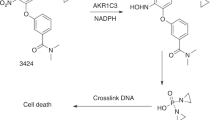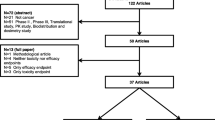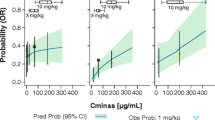Summary
The standard approaches to initial dose selection and dose escalation in phase I trials may be inappropriately conservative. These approaches mandate accrual of large numbers of patients, most of whom are treated at low and potentially ineffective doses. We compared the clinically determined maximum tolerable dose (MTD) with the starting dose of 45 drugs that had undergone phase I studies during the period 1977–1989. We also examined the number of dose-escalation steps required to achieve the MTD in relation to nonhematologic and hematologic dose-limiting toxicity. The median ratio of MTD to starting dose for all drugs was 20 (range, <1–433) and the median number of dose levels studied to reach the MTD was 8 (range, 0–23). For drugs with nonhematologic dose-limiting toxicity, the median ratio of MTD to starting dose was 30 (range, 3–385) as compared with 12.8 (range, <1–433) for those with hematologic dose-limiting toxicity (P=0.023). The median number of dose-escalation steps required to reach the MTD was 9 (range, 2–18) for drugs with nonhematologic dose-limiting toxicity as compared with 5.5 (range, 0–23) for those with hematologic dose-limiting toxicity (P=0.038). We also examined the response rate for 1,110 patients treated with 21 phase-I-study drugs for which response information was available. Responses were reported for 29 patients (2.6%). Among the 476 patients treated at the 3 highest dose steps, 17 responded (3.6%), which is double the response rate obtained at the lower doses (P=0.08). It is suggested that although the usual methods for choosing starting doses and dose-escalation schemes for phase I studies are safe, they are overly conservative and delay opportunities for therapeutic benefit in phase I and subsequent phase II trials.
Similar content being viewed by others
References
Collins JM, Zaharko DS, Dedrick RL, Chabner BA (1986) Potential roles for preclinical pharmacology in phase I clinical trials. Cancer Treat Rep 70:73
Collins JM, Grieshaber CK, Chabner BA (1990) Pharmacologically guided phase I clinical trials based upon preclinical drug development. J Natl Cancer Inst 82:1321
EORTC Pharmacokinetics and Metabolism Group (1987) Pharmacokinetically guided dose escalation in phase I clinical trials. Commentary and proposed guidelines. Eur J Cancer Clin Oncol 23:1083
Gianni L, Vigano L, Surbone A, Ballinar D, Casali P, Tarella C, Collins JM, Bonadonna G (1990) Pharmacology and clinical toxicity of 4′-iodo-4′-deoxydoxorubicin: an example of successful application of pharmacokinetics to dose escalation in phase I trials. J Natl Cancer Inst 82:469
Goldsmith MA, Slavik M, Carter SK (1975) Quantitative prediction of drug toxicity in humans from toxicology in small and large animals. Cancer Res 35:1354
Guarino AM, Rozencweig M, Kline I, Penta JS, Venditti JM, Lloyd HH, Holzworth DA, Muggia FM (1979) Adequacies and inadequacies in assessing murine toxicity data with antineoplastic agents. Cancer Res 39:2204
Hansen H (1970) Clinical experience with 1-(2-chloroethyl)-3-cyclohexyl-1-nitrosurea (CCNU-NSC 79 037) (abstract). Proc Am Assoc Cancer Res 11:87
Muggia FM (1970) Phase I study of 4′-demethyl-epipodophyllotoxin-b-d-thenylidene glycoside (PTG, NSC 122819) (abstract). Proc Am Assoc Cancer Res 11:58
Penta JS, Rozencweig M, Guarino AM, Muggia FM (1979) Mouse and large-animal toxicology studies of twelve antitumor agents: relevance to starting dose for phase I clinical trials. Cancer Chemother Pharmacol 3:97
Prieur DJ (1973) Procedures for preclinical toxicologic evaluation of chemotherapeutic agents: protocols of the laboratory of toxicology. Cancer Chemother Rep 4 (3):1
Rozencweig M, Von Hoff DD, Staquet MJ, Schein PS, Penta JS, Goldin A, Muggia FM, Freireich EJ, DeVita VT (1981) Animal toxicology for early clinical trials with anticancer agents. Cancer Clin Trials 4:41
Storer B, DeMets D (1987) Current phase I/II designs: are they adequate. J Clin Res Drug Dev 1:121
Von Hoff DD, Turner J (1991) Response rates, duration of response, and dose response effect in phase I studies of antineoplastics. Invest New Drugs 9:115
Author information
Authors and Affiliations
Additional information
This research was supported in part by NCI grant 2P30-CA-14236-16
Rights and permissions
About this article
Cite this article
Penta, J.S., Rosner, G.L. & Trump, D.L. Choice of starting dose and escalation for phase I studies of antitumor agents. Cancer Chemother. Pharmacol. 31, 247–250 (1992). https://doi.org/10.1007/BF00685555
Received:
Accepted:
Issue Date:
DOI: https://doi.org/10.1007/BF00685555




